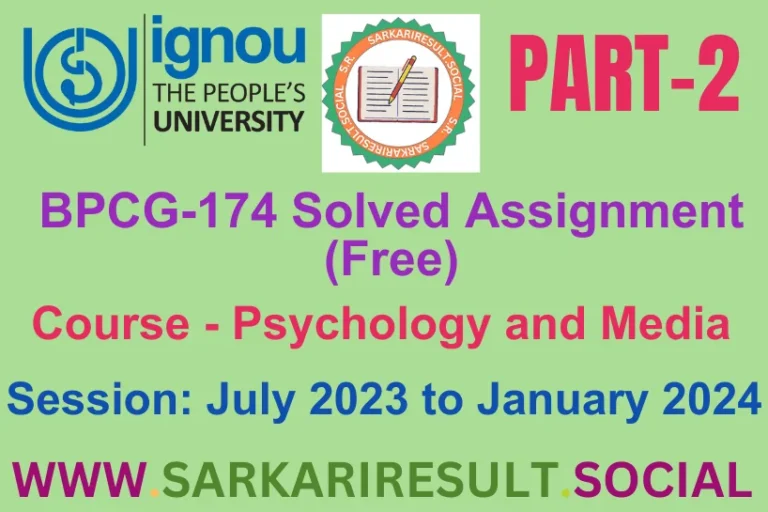TOP BPCG – 173 IGNOU SOLVED ASSIGNMENT (FREE) in 2023-24

BPCG – 173 IGNOU SOLVED ASSIGNMENT (FREE) in 2023-24
BPCG – 173 IGNOU SOLVED ASSIGNMENT (FREE) in 2023-24 -IGNOU’s BPCG 173, which focuses on “Psychology for Health and Wellbeing,” is a significant course. It explains how psychology and general well-being are related and teaches students how to improve their mental health for a happy existence. For academic assessment, knowledge application, skill development, ongoing learning, and personal development, submitting course assignments is essential. This website promotes accessibility to education for everyone by delivering time efficiency, assistance, and support through the provision of free solved assignments, including BPCG – 173 IGNOU SOLVED ASSIGNMENT (FREE) in 2023-24.
Questions and Answers (Solved)
Section A

Q.1 Define coping and explain its goals. Describe various coping styles.
Ans. Coping can be defined as the cognitive and behavioral efforts made by individuals to manage, tolerate, or adapt to challenging situations, stress, or emotional distress. It is an essential aspect of human functioning that helps individuals navigate through difficult circumstances and maintain their emotional well-being. Coping strategies vary widely among individuals and can have significant effects on mental health and overall life satisfaction.
The primary goals of coping are to reduce emotional distress, manage stress effectively, and restore a sense of balance and control in one’s life. When faced with adverse situations, coping mechanisms aim to help individuals cope with the emotional and psychological impact by promoting resilience, problem-solving, and emotional regulation.
There are various coping styles that individuals may adopt depending on their personality, upbringing, and experiences. Some common coping styles include:
- Problem-Focused Coping: This approach focuses on addressing the root cause of the stressor and taking practical steps to resolve the problem. Individuals employing problem-focused coping may seek information, make plans, and engage in active problem-solving to reduce stress.
- Emotion-Focused Coping: This style involves managing emotions and reducing distress without necessarily addressing the underlying problem. Individuals may use techniques such as seeking emotional support, venting, or engaging in relaxation activities to cope with stress.
- Avoidant Coping: Avoidant coping refers to efforts made to escape or avoid dealing directly with the stressor. This may include denial, distraction, or engaging in activities that temporarily take the person’s mind off the problem.
- Social Support Seeking: People using this coping style seek assistance, empathy, and understanding from friends, family, or support groups. Social support can provide comfort and validation during difficult times.
- Religious or Spiritual Coping: Involves turning to one’s religious or spiritual beliefs and practices to find comfort, meaning, and strength during challenging situations.
- Cognitive Restructuring: This coping style involves reevaluating and changing one’s thought patterns and beliefs about the stressor to reduce negative emotional responses and improve coping.
- Humor and Positive Coping: Using humor to find lightness in difficult situations and focusing on positive aspects can be an effective way to cope with stress.
- Physical Activity: Engaging in physical exercise or activities can be a healthy way to manage stress and release pent-up emotions.
- Substance Use and Avoidance: Unfortunately, some individuals may turn to alcohol, drugs, or other harmful behaviors as a maladaptive way to cope with stress, which can lead to further problems.
It’s important to understand that coping mechanisms are not necessarily good or evil; rather, their efficacy relies on the situation, the individual, and their particular requirements and circumstances. While certain coping mechanisms might increase resilience and general well-being, others can have the opposite effect or only provide momentary comfort without addressing the underlying problem. Therefore, building a toolkit of adaptive coping techniques is essential to fostering mental health and successfully navigating the obstacles of life. It can also be helpful to seek professional assistance, such as counseling or therapy, in order to successfully manage stress and establish healthy coping strategies.
Q.2 Explain the strength-based approach to work. Describe the nine components of gainful employment.
Ans. Strength-Based Approach to Work: The strength-based approach to work is a philosophy that focuses on identifying and leveraging an individual’s strengths, talents, and positive attributes in the workplace. It is a departure from the traditional deficit-based approach, which primarily concentrates on addressing weaknesses and areas of improvement. The strength-based approach recognizes that each person possesses unique abilities that, when utilized effectively, can lead to increased engagement, productivity, and overall job satisfaction.
In the context of the strength-based approach, employers and managers strive to:
- Identify Strengths: Acknowledge and identify the unique strengths and skills of each employee through assessments, feedback, and open communication.
- Assign Roles Appropriately: Assign tasks and responsibilities that align with employees’ strengths and interests to ensure they are engaged and motivated in their work.
- Encourage Growth: Provide opportunities for employees to further develop and refine their strengths through training, workshops, and mentorship programs.
- Foster a Positive Work Environment: Create a supportive and positive work culture that celebrates achievements, encourages collaboration, and values individual contributions.
- Recognize and Appreciate: Acknowledge and appreciate employees’ efforts and accomplishments, reinforcing their strengths and boosting morale.
- Promote Autonomy: Grant employees a certain level of autonomy and decision-making authority in areas that complement their strengths.
- Build on Diversity: Recognize and value the diverse strengths and perspectives that each employee brings to the organization.
- Adaptability: Be flexible and adaptive in job design and team structure to accommodate individual strengths.
- Goal Alignment: Align individual strengths with the overall goals and objectives of the organization to maximize performance and outcomes.
By adopting a strength-based approach, organizations can create a more engaged and motivated workforce, leading to increased productivity, employee retention, and overall job satisfaction.
Nine Components of Gainful Employment:
Gainful employment refers to a type of work that provides individuals with the means to support themselves financially and contribute positively to society. The nine components of gainful employment are:
- Sufficient Income: Employment should provide an income that meets or exceeds basic living expenses, ensuring financial stability and reducing the risk of poverty.
- Safe and Healthy Working Conditions: The workplace should prioritize the safety and well-being of employees, maintaining appropriate safety standards and promoting a healthy work environment.
- Equal Opportunities: Gainful employment should be accessible to all individuals, regardless of their background, gender, ethnicity, or any other characteristic protected by law.
- Job Security: Employees should have reasonable job security, minimizing the fear of sudden job loss and promoting a sense of stability.
- Career Advancement: Opportunities for career growth and advancement should be available to employees, allowing them to improve their skills and take on higher responsibilities.
- Work-Life Balance: Gainful employment should support a healthy work-life balance, enabling individuals to fulfill their personal and family commitments without compromising their job performance.
- Social Benefits: Employment should provide social benefits, such as access to healthcare, retirement plans, and other support systems that contribute to overall well-being.
- Social Inclusion: Gainful employment should promote social inclusion, where employees feel valued, respected, and integrated into the workplace community.
- Contributing to Society: The work undertaken should have a positive impact on society, whether through providing valuable goods and services or supporting community initiatives.
Section B

Q.3 Explain the cross-cultural perspectives on health.
Ans. Cross-cultural perspectives on health refer to the examination and understanding of health and healthcare practices within different cultural contexts. Health beliefs, attitudes, and behaviors can vary significantly among diverse cultural groups, impacting how individuals perceive, manage, and seek treatment for health-related issues. Such perspectives consider the cultural, social, and historical factors that shape health practices and beliefs.
These perspectives recognize that health is not solely a biological or medical concept but is deeply influenced by cultural norms, values, and traditions. Different cultures may have unique concepts of illness causation, treatment methods, and healing practices. For example, some cultures may emphasize holistic approaches to health, viewing the mind, body, and spirit as interconnected, while others may rely on specific rituals or herbal remedies.
Understanding cross-cultural perspectives on health is crucial for healthcare providers, policymakers, and researchers to deliver effective and culturally competent care. It helps to identify potential barriers to healthcare access, improve communication between healthcare professionals and patients from diverse backgrounds, and develop interventions that respect and integrate cultural beliefs and practices into healthcare services. Overall, considering cross-cultural perspectives on health contributes to more equitable and inclusive healthcare delivery for all individuals, regardless of their cultural background.
Q.4 Describe the techniques of time management.
Ans. Time management involves the effective utilization of time to accomplish tasks, meet deadlines, and achieve goals. Several techniques can help individuals improve their time management skills:
- Prioritization: Identify and rank tasks based on their importance and urgency. Focus on high-priority tasks first to ensure critical deadlines are met.
- To-Do Lists: Create daily or weekly to-do lists to keep track of tasks and stay organized. Check off completed items to maintain a sense of accomplishment.
- Time Blocking: Allocate specific blocks of time for different tasks or activities. This helps maintain focus and prevents distractions.
- Set Realistic Goals: Establish achievable and realistic goals to avoid feeling overwhelmed and maintain motivation.
- Eliminate Time Wasters: Identify and eliminate activities that consume time but offer little value. Minimize distractions like excessive social media use or unnecessary meetings.
- Single-Tasking: Concentrate on one task at a time rather than multitasking, as it improves efficiency and reduces errors.
- Learn to Say No: Avoid overcommitting by learning to say no to additional tasks or responsibilities that might interfere with existing priorities.
- Break Tasks into Smaller Steps: Divide larger tasks into smaller, manageable steps. This approach makes it easier to track progress and stay motivated.
- Use Technology Wisely: Utilize productivity tools and apps, such as calendars, task managers, and reminders, to organize schedules and set alarms for important deadlines.
- Time Audit: Regularly assess how time is being spent to identify areas for improvement and adjust time management strategies accordingly.
Q.5 Explain anxiety disorders as stated in DSM 5.
Ans. Anxiety disorders, as defined in the Diagnostic and Statistical Manual of Mental Disorders (DSM-5), are a group of mental health conditions characterized by excessive and persistent feelings of fear, worry, or apprehension that significantly impact an individual’s daily life. The DSM-5 identifies several specific anxiety disorders:
- Generalized Anxiety Disorder (GAD): GAD involves chronic and excessive worry and anxiety about various aspects of life, such as work, relationships, and health, lasting for at least six months.
- Panic Disorder: Panic disorder involves recurring and unexpected panic attacks, which are intense periods of overwhelming fear and physical symptoms like heart palpitations, sweating, and shortness of breath.
- Social Anxiety Disorder (Social Phobia): This disorder entails intense fear and anxiety about social situations where an individual may be scrutinized or judged by others, leading to avoidance of such situations.
- Specific Phobia: Specific phobia is characterized by extreme and irrational fear of a specific object or situation, such as heights, animals, or flying.
- Agoraphobia: Agoraphobia involves fear and avoidance of situations or places where escape might be challenging or where help might not be available, such as crowded spaces or public transportation.
- Separation Anxiety Disorder: This condition primarily affects children and involves excessive anxiety about separation from attachment figures, leading to distress or impairment in social and academic functioning.
These anxiety disorders can cause significant distress, impair daily functioning, and lead to physical symptoms like headaches or gastrointestinal problems. They may also co-occur with other mental health conditions, such as depression or substance use disorders.
Section-C

Q.6 Biopsychosocial model of health.
Ans. The biopsychosocial model of health is a comprehensive approach that considers biological, psychological, and social factors in understanding and treating health and illness. It recognizes that physical health is influenced by a combination of biological processes, psychological factors (thoughts, emotions, behavior), and social determinants (environment, culture, family). By considering these interconnected aspects, the model provides a more holistic understanding of health, guiding healthcare professionals in developing effective interventions and treatments that address multiple dimensions of well-being.
Q.7 Symptoms of stress.
Ans. Symptoms of stress typically include physical, emotional, cognitive, and behavioral responses to challenging situations. Physical symptoms may include headaches, muscle tension, or fatigue. Emotional symptoms can manifest as anxiety, irritability, or sadness. Cognitive symptoms may involve difficulty concentrating or making decisions. Behavioral symptoms might include changes in eating or sleeping habits, withdrawal from social activities, or increased substance use. Persistent and overwhelming stress can have detrimental effects on both mental and physical health, underscoring the importance of stress management techniques to maintain well-being.
Q.8 Inverted -U.
Ans. The Inverted-U, also known as the Yerkes-Dodson law, illustrates the relationship between arousal and performance. According to this theory, performance improves with increasing arousal, up to an optimal point. Beyond this point, further arousal leads to a decline in performance. This concept is often applied in sports, psychology, and other performance-related fields to explain the ideal balance between anxiety and performance. Different tasks may have varying optimal arousal levels, and finding the right balance is crucial for achieving peak performance.
Q.9 Meditation.
Ans. Meditation is a practice that involves focusing attention and eliminating distracting thoughts to achieve a mentally clear and emotionally calm state. It is commonly used for relaxation, stress reduction, and enhancing self-awareness. Various meditation techniques exist, including mindfulness meditation, transcendental meditation, and loving-kindness meditation. Research has shown that regular meditation can have positive effects on mental health, reducing anxiety, depression, and improving overall well-being.
Q.10 Epilepsy.
Ans. Epilepsy is a neurological disorder characterized by recurrent and unpredictable seizures, caused by abnormal brain activity. Seizures can range from mild and brief to severe and prolonged, and their symptoms vary depending on the affected brain regions. Common seizure signs include convulsions, loss of consciousness, and unusual behaviors. Epilepsy can be managed with antiepileptic medications or other treatments, allowing many individuals to lead fulfilling lives. However, it is essential to work closely with healthcare professionals to tailor treatment and support based on individual needs.
Disclaimer
The following questions and answers BPCG 173 Ignou Solved Assignment (FREE) 2023-24 have been provided for informational purposes only. While efforts have been made to provide accurate and up-to-date information, the content should not be considered as professional advice. Users are encouraged to verify any information independently. The website and its operators do not assume any liability for the use or interpretation of the content provided. Visitors are advised to consult relevant experts or professionals for specific guidance and assistance. By using this website, you agree that the website and its operators are not responsible for any consequences arising from the use of the information provided. Thank you !!!







